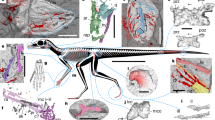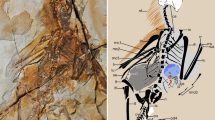Abstract
Considerable debate surrounds the numerous avian-like traits in core maniraptorans (oviraptorosaurs, troodontids, and dromaeosaurs), especially in the Chinese Early Cretaceous oviraptorosaur Caudipteryx, which preserves modern avian pennaceous primary remiges attached to the manus, as is the case in modern birds. Was Caudipteryx derived from earth-bound theropod dinosaurs, which is the predominant view among palaeontologists, or was it secondarily flightless, with volant avians or theropods as ancestors (the neoflightless hypothesis), which is another popular, but minority view. The discovery here of an aerodynamic propatagium in several specimens provides new evidence that Caudipteryx (and hence oviraptorosaurs) represent secondarily derived flightless ground dwellers, whether of theropod or avian affinity, and that their presence and radiation during the Cretaceous may have been a factor in the apparent scarcity of many other large flightless birds during that period.
Zusammenfassung
Die „Neoflightless“-Hypothese im Test: Halsflughaut (Propatagium) offenbart flugfähige Vorfahren der Oviraptorosauria
Es gibt eine ausgiebige Debatte über die zahlreichen vogelähnlichen Eigenheiten der Maniraptora (Oviraptosaurus, Troodontidae, Dromaeosaurus), vor allem des (gefiederten) Oviraptorosauria Caudipteryx aus der frühen chinesischen Kreidezeit, der genau wie rezente Vögel Handschwingen hatte, die an den Handknochen ansetzen. Stammt Caudipteryx von den nur am Erdboden lebenden Theropoda ab - die unter den Paläontologen vorherrschende Meinung -, oder war er sekundär flugunfähig und stammte von flugfähigen Theropoden ab - die „Neoflightless“-Hypothese, eine alternative, wenn auch nur von Wenigen unterstützte These. Die hier berichtete Entdeckung einer aerodynamischen Halsflughaut bei einigen Exemplaren gibt neue Hinweise darauf, dass Caudipteryx (und damit auch Oviraptorosaurus) einen sekundär flugunfähigen Bodenbewohner darstellte, ganz gleich, ob er näher mit den Theropoden oder den Vögeln verwandt ist. Sein Vorkommen und seine Ausbreitung während der Kreidezeit war möglicherweise ein Faktor im offensichtlichen Mangel an anderen großen, flugunfähigen Vögeln während dieser Periode.




Similar content being viewed by others
References
Agnolín FL, Novas FE (2013) Avian ancestors: a review of the phylogenetic relationships of the theropods Unenlagiidae, Microraptoria, Anchiornis and Scansoriopterygidae. Springer Briefs in Earth Systems Sciences, Springer, Dordrecht, Heidelberg, Springer SBM
Altangerel P, Norell MA, Chiappe LM, Clark JM (1993) Flightless bird from the Cretaceous of Mangolia. Nature 262:623–626
Balanoff AM, Xu X, Kobayashi Y, Matsufune Y, Norell MA (2009) Cranial osteology of the theropod dinosaur Incisivosaurus gauthieri (Theropoda: Oviraptorosauria). Am Mus Novitates 3651:1–36
Barrett PM, Hilton JM (2006) The Jehol Biota (Lower Cretaceous, China): new discoveries and future prospects. Integr Zool 1:11–17
Brown RE, Cogley AC (1996) Contributions of the propatagium to avian flight. J Exp Zool 276:112–124
Buffetaut E, Le Loeuff J (1998) A new giant ground bird from the Upper Cretaceous of southern France. J Geol Soc London 155:1–4
Chatterjee S, Templin RJ (2012) Palaeoecology, aerodynamics, and the origin of avian flight. In: Talent JA (ed) Earth and life, international year of planet earth. Springer, New York, pp 585–612
Chiappe L, Lacasa-Ruiz J (2002) Noguerornis gonzalezi (Aves: Ornithothoraces) from the Early Cretaceous of Spain. In: Chiappe LM, Witmer L (eds) Mesozoic birds: above the heads of dinosaurs. University of California Press, Berkeley, pp 230–239
Czerkas SA, Feduccia A (2014) Jurassic archosaur is a non-dinosaurian bird. J Ornithol 155:841–851
de Beer G (1956) The evolution of ratites. Bull Brit Mus (Nat Hist) 4:59–70
Elzanowski A (1999) A comparison of the jaw skeleton in theropods and birds, with a description of the palate in the Oviraptoridae. Smithsonian Contr Paleobiol 89:311–323
Feduccia A (2012) Riddle of the feathered dragons. Yale University Press, New Haven
Feduccia A (2013) Bird origins anew. Auk 130:1–12
Feduccia A (2014) Avian extinction at the end of the Cretaceous: Assessing the magnitude and subsequent explosive radiation. Cret Res 50:1–15
Foth C, Tischlinger H, Rauhut OWM (2014) New specimen of Archaeopteryx provides insights into the evolution of pennaceous feathers. Nature 511(7507):79–82
Gee H (1998) Birds and dinosaurs—the debate is over. Nature News (online). doi:10.1038/news980702-8
Gong E-P, Martin LD, Burnham DA, Falk AF, L-h Hou (2012) A new species of Microraptor from the Jehol Biota of northeastern China. Palaeoworld 21:81–91
Hertel F, Campbell KE (2007) The antitrochanter or birds: form and function in balance. Auk 124:789–805
Hone DWE, Tischlinger H, Xing X, Zhang F (2010) The extent of the preserved feathers on the four-winged dinosaur Microraptor gui under ultraviolet light. PLoS One 5(2):e9223. doi:10.1371/journal.pone.0009223
Hu D, L-h Hou, Zhang L, Xu X (2009) A pre-Archaeopteryx troodontid theropod from China with long feathers on the metatarsus. Nature 461:640–643
James FC, Pourtless JA IV (2009) Cladistics and the origin of birds: a review and two new analyses. Orn Monogr 66:1–78
Ji Q, Currie PJ, Norell MA, Ji S-A (1998) Two feathered dinosaurs from northeastern China. Nature 393:753–761
Jones TD, Farlow JO, Ruben JA, Henderson DM, Hillenius WJ (2000) Cursoriality in bipedal archosaurs. Nature 406(6797):716–718
Kavanau JL (2010) Secondarily flightless birds or Cretaceous non-avian theropods. Med Hypotheses 74(2):275–276
Kundrát M (2007) Avian-like attributes of a virtual brain model of the oviraptorid theropod Conchoraptor gracilis. Naturwissenschaften 994:499–504
Kundrát M, Janáček J (2007) Cranial pneumatization and auditory perceptions of the oviraptorid dinosaur Conchoraptor gracilis (Theropoda, Maniraptora) from the Late Cretaceous of Mongolia. Naturwissenschaften 94:769–778
Livesey BC (1995) Heterochrony and the evolution of avian flightlessness. In: McNamara EJ (ed) Evolutionary change and heterochrony. John Wiley & Sons, New York, pp 169–193
Lowe PR (1928a) Studies and observations bearing on the phylogeny of the Ostrich and its allies. Proc Zool Soc London 1928:185–247
Lowe PR (1928b) A description of Atlantisia rogersi, the diminutive and flightless rail of Inaccessible Island (Southern Atlantic) with some notes on flightless rails. Ibis 1928:99–131
Lowe PR (1934) On the evidence of the existence of two species of Steamer Ducks (Tachyeres), and primary and secondary flightlessness in birds. Ibis 1934:467–495
Lü J, Dong Z, Azuma Y, Barsbold R, Tomida Y (2002) Oviraptorosaurs compared to birds. In: Zhou Z, Zhang F (eds) Proc 5th Symp soc avian paleontol evol. Science Press, Beijing, pp 175–189
Martin LD, Lim JD (2005) Soft body impression of the hand of Archaeopteryx. Curr Sci 89(7):1089–1090
Maryańska T, Osmólska H, Wolsan M (2002) Avialan status for Oviraptorosauria. Acta Palaeontol Polonica 47(1):97–116
Mayr G, Pohl B, Peters DS (2005) A well-preserved Archaeopteryx specimen with theropod features. Science 310:1483–1486
McGowan C (2009) The wing musculature of the Weka (Gallirallus australis) a flightless rail endemic to New Zealand. J Zool 210(3):305–346
Olshevsky G (1992) A revision of the parainfraclass Archosauria Cope, 1869, excluding the advanced Crocodylia. Mesozoic Meanderings 2:1–268
Padian K, Chiappe LM (1998) The origin of birds and their flight. Sci Am 278:38–47
Paul GS (2002) Dinosaurs of the air: The evolution and loss of flight in dinosaurs and birds. Johns Hopkins University Press, Baltimore
Prum RO (2010) Moulting tail feathers in a juvenile ovraptorsaur. Nature Rapid Commun 468:E1
Sereno PC (1999) The evolution of dinosaurs. Science 284:2137–2147
Vasquez RJ (1994) Functional osteology of avian wrist and evolution of flapping flight. J Morph 211:259–268
Xu X, Norell MA (2006) Non-avian dinosaur fossils from the Lower Cretaceous Jehol Group of western Liaoning, China. Geol J 41:419–437
Xu X, Zhou Z, Wang X, Kuang X, Zhang F, Du X (2003) Four-winged dinosaurs from China. Nature 421:335–340
Xu X, You H, Du K, Han F (2011) An Archaeopteryx-like theropod from China and the origin of Avialae. Nature 475:465–470
Zhang F, Zhou Z, Xu X, Wang X (2002) A juvenile coelurosaurian theropod from China indicates arboreal habits. Naturwissenschaften 89(9):394–398
Zhou Z, Wang X (2000) A new species of Caudipteryx from the Yixian Formation of Liaoning, northeast China. Vert Palasiatica 38(2):113–130
Zhou Z, Zhang F (2006) Mesozoic birds of China. Vert PalAsia 44(1):74–98
Zhou Z, Wang X, Zhang F, Xu X (2000) Important features of Caudipteryx—evidence from two nearly complete new specimens. Vert Palasiatica 38(4):241–254
Acknowledgments
We thank Sylvia J. Czerkas, Director of the Dinosaur Museum, for review and other important discussion. Zhonghe Zhou, Institute for Vertebrate Paleontology and Paleoanthropology, Beijing, identified a propatagium in a specimen of Caudipteryx in the collections of the IVPP and kindly provided useful discussion and photos of specimens under his care. We thank Ji Qiang of the Institute of Geology, Chinese Academy of Geological Sciences for help and discussion. The specimen on loan from the Institute of Geology has been returned to China. Susan Whitfield rendered the figures.
Author information
Authors and Affiliations
Corresponding author
Additional information
Communicated by F. Bairlein.
Rights and permissions
About this article
Cite this article
Feduccia, A., Czerkas, S.A. Testing the neoflightless hypothesis: propatagium reveals flying ancestry of oviraptorosaurs. J Ornithol 156, 1067–1074 (2015). https://doi.org/10.1007/s10336-015-1190-9
Received:
Revised:
Accepted:
Published:
Issue Date:
DOI: https://doi.org/10.1007/s10336-015-1190-9




